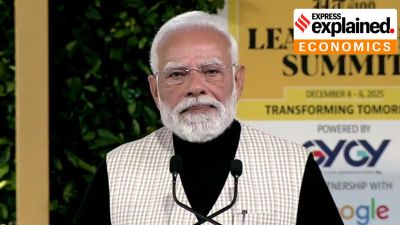MLF revisits Maharaja Ranjit Singh’s secular legacy
Opening the discussion, Amardeep questioned the modern use of the term “Sikh Empire,” saying it originated largely in British colonial writing and did not reflect the plural character of Ranjit Singh’s administration.
 Day 1 of exhibition “The Sikh Empire (1710–1849)” at the Military Lit. Festival, Chandigarh. (Source: @panjabdigilib)
Day 1 of exhibition “The Sikh Empire (1710–1849)” at the Military Lit. Festival, Chandigarh. (Source: @panjabdigilib)The concluding session of the 9th Military Literature Festival (MLF) held at the Lake Club on Saturday called for a re-examination of Maharaja Ranjit Singh’s reign, urging scholars to view it as a secular and inclusive model of governance rather than through narrow religious definitions.
Visual ethnographic researcher Amardeep Singh, known for his cross-border documentation project “Lost Heritage”, delivered a detailed presentation on the political, social and military dimensions of the Lahore Darbar’s expansion into Ladakh, Baltistan and western Tibet in the early 19th century.
Opening the discussion, Amardeep questioned the modern use of the term “Sikh Empire,” saying it originated largely in British colonial writing and did not reflect the plural character of Ranjit Singh’s administration. The state, he noted, referred to itself as the Lahore Darbar or Khalsa Sarkar and included Sikhs, Muslims, Hindus, Dogras and Europeans in both its military and civil institutions.
“Ranjit Singh’s army and administration reflected the diversity of Punjab of that era,” Amardeep said. “Several senior generals and administrators came from Muslim and Hindu communities, alongside Sikhs and Europeans. To see this empire only through a religious identity narrows its vast and shared heritage.”
Securing the Frontier
Amardeep described the early phase of Ranjit Singh’s rule as a determined effort to protect Punjab from repeated invasions. From 1809 onward, the Lahore Darbar invested heavily in fortifying its north-western frontier, particularly along routes through the Khyber Pass.
One of the central figures in this campaign was General Hari Singh Nalwa, a renowned commander who led decisive operations that extended the Darbar’s authority. His victories in Multan in 1818 and Kashmir in 1819 consolidated control over key trade and military routes. The construction of Jamrud Fort in 1836 at the entrance of the Khyber Pass marked a major achievement in curbing Afghan incursions.
Beyond military success, Nalwa established Haripur in present-day Khyber Pakhtunkhwa as a well-planned administrative and trading centre. Amardeep described how regional traditions still remember Nalwa as a protector who restored stability to areas long affected by conflict.
Into the Himalayas
The following stage of northern expansion was undertaken by General Zorawar Singh, a Dogra officer serving under Raja Gulab Singh of Jammu, who in turn served the Lahore Darbar. Between 1834 and 1841, Zorawar Singh led a series of challenging campaigns through Ladakh, Baltistan and western Tibet.
In 1834, he advanced his army through the difficult Kishtwar-Zanskar route to capture Ladakh, making Leh a strategic outpost under Darbar control. A few years later, his troops annexed Baltistan after sustained engagements that led local rulers to surrender.
The most ambitious campaign began in mid-1841 when Zorawar Singh’s forces entered Ngari in western Tibet and captured Taklakot (Purang). While historians have debated the motive behind this expansion, Singh suggested it was driven by shifting geopolitical dynamics in the Himalayas, including growing British presence.
The campaign ended tragically when Tibetan and Qing forces launched a winter counter-offensive. Zorawar Singh was killed in battle near Minsar on December 12, 1841. Surviving soldiers retreated through freezing passes, with some officers eventually reaching British-held territories.
Legacy beyond borders
Amardeep presented historical and Tibetan accounts that record how several captured soldiers later settled in Tibet, marrying locally and integrating into Tibetan society. Their descendants came to be known as “Singpa Khache,” tracing their lineage to the Dogra-Ladakhi troops of the Lahore Darbar.
He said this illustrated the Darbar’s plural and secular identity. Concluding his address, Amardeep called for academic and cultural institutions to move beyond sectarian lenses. “The Lahore Darbar was built through shared contributions,” he said.
The author is an intern with The Indian Express







